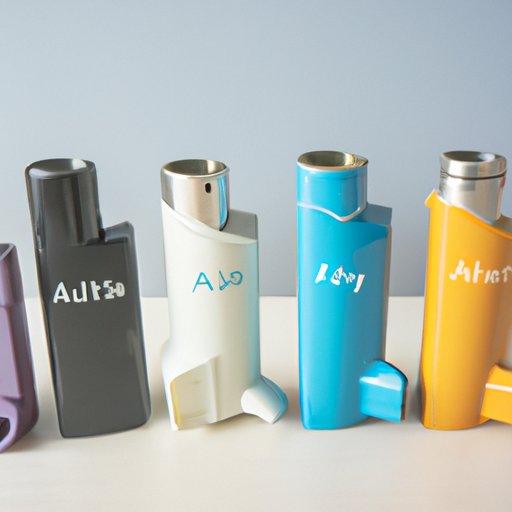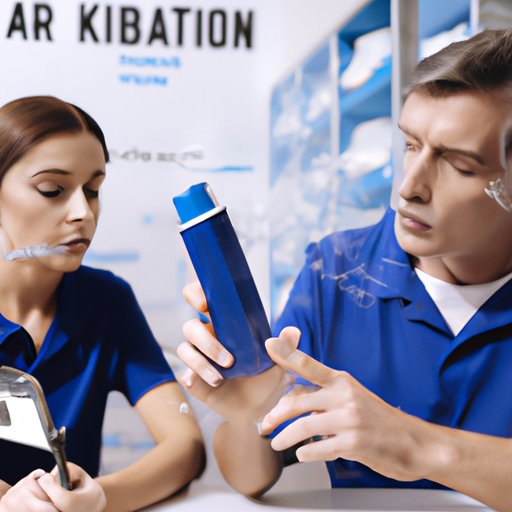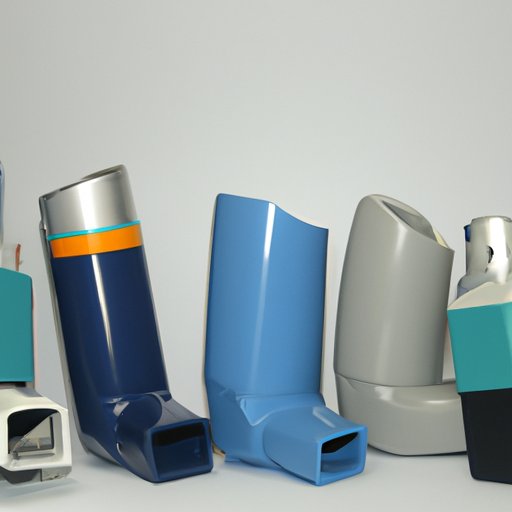Introduction
An inhaler is a device used to deliver medication directly into the lungs. This type of medication delivery is known as inhalation therapy, and it is an effective way to treat a variety of respiratory conditions such as asthma and chronic obstructive pulmonary disease (COPD). In this article, we will explore how an inhaler works, the different types of inhalers available, and the benefits and potential side effects of inhaled medications.
Exploring the Function and Components of an Inhaler
Inhalers are designed to deliver medication directly to the lungs, where it can be quickly absorbed into the bloodstream. The medication is usually in the form of an aerosol or mist, which helps the medication travel deep into the lungs. An inhaler typically consists of a chamber that holds the medication, a mouthpiece, and a propellant to help push the medication out of the device.
Inhalers come in three main types: metered dose inhalers (MDIs), dry powder inhalers (DPIs), and soft mist inhalers (SMIs). MDIs contain a pressurized canister of medication, while DPIs use a rotating mechanism to dispense the medication. SMIs are the newest type of inhaler, and they employ a gentle spray of medication that is released when the user inhales.
A Step-by-Step Guide to Using an Inhaler
Using an inhaler correctly is essential for the best results. Here is a step-by-step guide to using an inhaler:
1. Prepare the inhaler by shaking it vigorously for 10 seconds. Make sure the mouthpiece is clean and there is no blockage in the airways.
2. Take a deep breath and then place the mouthpiece in your mouth. Seal your lips around the mouthpiece and press down on the canister to release one puff of medication.
3. Begin to inhale slowly and deeply, and continue inhaling until all of the medication has been released.
4. Hold your breath for 10 seconds before exhaling.
5. After each use, rinse the mouthpiece with warm water and air dry thoroughly. Store the inhaler in a cool, dry place away from direct sunlight.

Investigating the Science Behind How Inhalers Work
The key to understanding how inhalers work is to understand the role of aerosols in delivering medication. Aerosols are tiny particles suspended in the air. When these particles enter the lungs, they are quickly absorbed into the bloodstream. This allows the medication to take effect more quickly than if it were ingested orally.
Inhalation also takes advantage of the physics of air pressure. When you inhale, the air pressure inside your lungs increases, causing the medication particles to be pushed deeper into the lungs, allowing them to be absorbed more quickly.

Comparing Different Types of Inhalers
MDIs are the most common type of inhaler. They are easy to use and require little maintenance, but they do require the user to coordinate their breathing and pressing the canister at the same time. DPIs are a newer type of inhaler and they do not require any coordination between inhaling and pressing the device. SMIs are the newest type of inhaler and they use a gentle spray of medication to make it easier for the user to inhale the medication.
Understanding the Benefits of Inhaled Medication
Inhaled medications offer several advantages over oral medications. First, inhaled medications are absorbed more quickly into the bloodstream, allowing them to take effect faster. Second, inhaled medications are more targeted to the lungs, reducing the risk of side effects associated with oral medications.
Examining the Potential Side Effects of Inhaled Medication
Although inhalers are generally safe and effective, they can cause some side effects. Common side effects include coughing or wheezing, throat irritation, and fungal infection in the mouth. If you experience any of these side effects, contact your doctor immediately.

Exploring Innovations in Inhaler Technology
In recent years, there have been several advances in inhaler technology. Electronic inhalers, for example, have been developed to make it easier for users to coordinate their breathing with the administration of the medication. Breath-actuated inhalers are also available, which automatically administer the medication when the user inhales.
Conclusion
Inhalers are an effective and convenient way to deliver medication to the lungs. This article explored the different types of inhalers, how they work, and the benefits and potential side effects of inhaled medications. We also discussed some of the innovations in inhaler technology, such as electronic and breath-actuated inhalers. Understanding how inhalers work can help ensure that you get the most benefit from your medication.
(Note: Is this article not meeting your expectations? Do you have knowledge or insights to share? Unlock new opportunities and expand your reach by joining our authors team. Click Registration to join us and share your expertise with our readers.)
